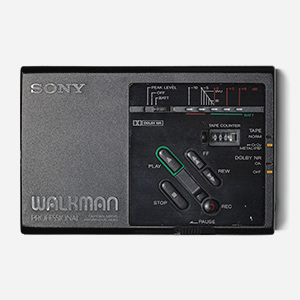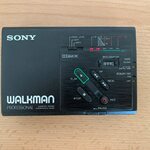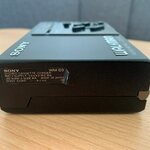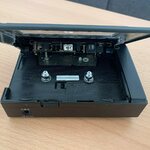 WM-D3
WM-D3

Technical details, specifications
- Battery
- 2AA
- Battery life
- 7 h
- Colors
- black
- Dimensions
- 125.4*37.3*82.3 mm (385 cm³)3D size
- Weight
- 370 gr
- Window
- yes
- Frame
- plastic
- Case
- metal
- Carry
- case
- Expandable
- no
- External compartment
- no
- Head
- Amorphous
- Drive
- Disc drive capstan servo
- Tape selector
- Manual switch
- Waterproof
- no
- Speaker
- no
- Frequency range
- 40-16000@1 Hz
- FMax output
- 2x20 mW
Functions
- DC in
- yes
- Record by input
- yes
- Record by int mic
- no
- Hotline mode
- no
- Cue
- yes
- Balance (L/R)
- no
- Phone type
- 3
- Equalizer
- no
- Auto reverse
- no
- Anti rolling
- yes
- Logic control
- no
- Hold lock
- no
- Noise reduction
- Dolby B NR
- Radio
- no
- Remote control
- no
- Wireless headphone
- no
- Indicator
- led
Description
The smaller Walkman Professional recorders, a DDII with additional components for recording borrowed from the WM-D6C.
The WM-D3 was the smaller of the two Walkman Professional recording models, the other being the WM-D6/WM-D6C. It was based around the same mechanicals as the WM-DD, and so had the same familiar layout of controls. An unfamiliar addition though was the pause control, which had a sliding action. This worked by switching off the motor, so introduced no extra mechanical complexity. The extra bulk of the high quality recording circuits made the WM-D3 slightly larger than the other WM-2 derivatives, with the recording preamplifiers being housed in an extra section of casing at one end. Unlike most of these models, the tape transport keys were part of the outer casework. For convenient desktop use, rubber feet were fitted to the four corners of the cassette door so that the machine could be placed “upside down” and operated without the need for a second hand to hold it steady. All the text and symbols were printed to be the correct way up when the machine was used this way.
What elevated the WM-D3 into the Professional range, above the level of the WM-R202 and others, was its ability to make recordings using Dolby NR and using either normal or chrome tape. Usually recording Walkmans could make basic recordings on ferric tape only, despite having playback facilities for a full range of recordings. Recording on chrome tape requires a lot more power than can be used of normal types, for both bias and erase. Because of this, the WM-D3 used a complex AC bias circuit and a double-gap ferrite erase head, the latter as an alternative to the hinged permanent magnet usually found on simpler Sony recorders. The WM-D3 was not quite as versatile as the WM-D6/WM-D6C, for it could not record on metal tape, nor did it offer Dolby C NR. Also absent when compared to these larger, more expensive models was the quartz locked capstan servo and variable playback speed control.
The WM-D3 offered a range of connections for external equipment, including line out, line in/microphone (switched by an attenuator) with plug-in power, stereo headphones and external 3V supply. The line out socket worked for playback only, so the WM-D3 could not be used in a “tape loop” with a hi-fi amplifier, as would be possible with a full size tape deck. A small stereo microphone was included with each machine. Recording level control was manual only, and to aid accurate adjustment a five segment LED level indicator was fitted, just like that of the larger professional models. This could also be set to show battery strength (using all five segments, an improvement over the arrangement fitted to the WM-D6) or switched off completely to conserve battery power.
The WM-D3 completed the Sony range of professional cassette models nicely, and was well respected for offering true hi-fi performance in the smallest possible size.Via Walkman Central












Comments
emiel80s @ 2024-04-05 19:33:56
It uses the same motor as the D6 and D6C, and that drives a disc like the other Disc Driven units.
aoszmdnj @ 2024-01-05 03:47:06
oh why is this considered dd walkman as well?
befresh @ 2022-12-28 09:12:43
This is also a DD walkman, maybe add it to that category as well?